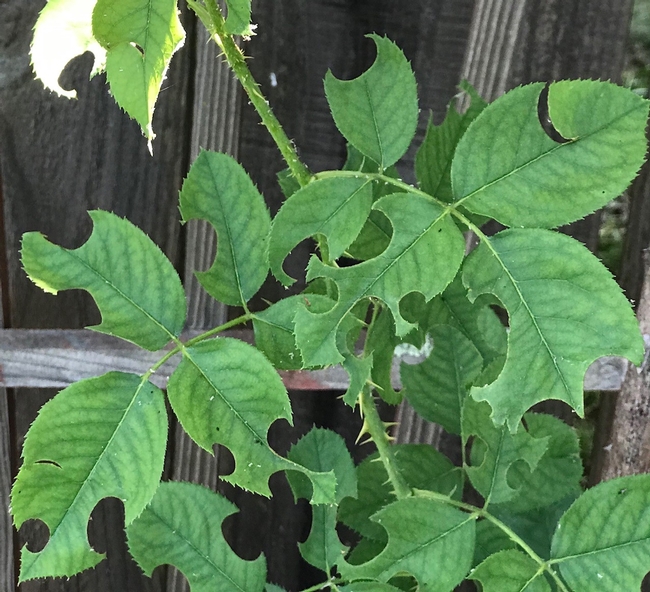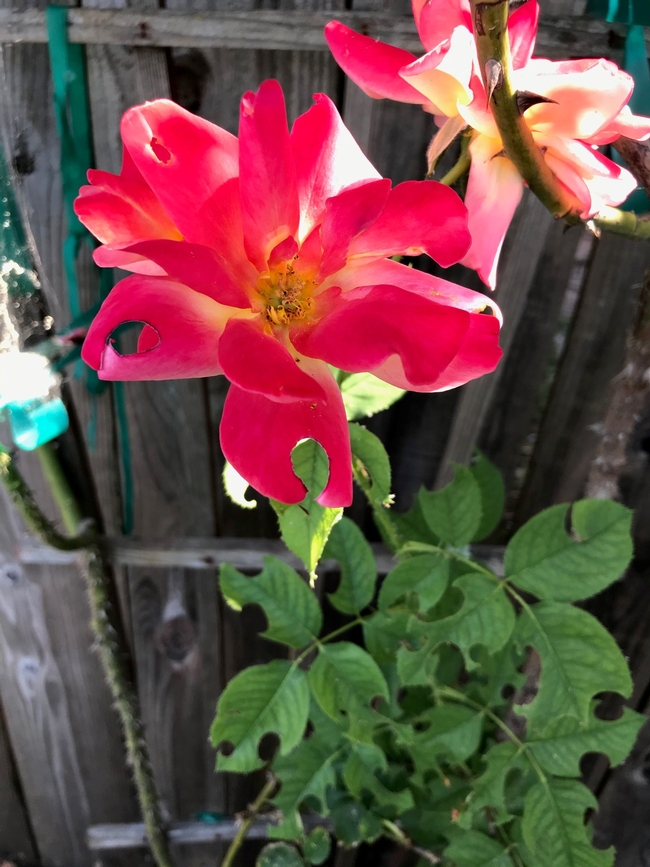Leafcutter Bees
I have had a Joseph's Coat climbing rose at my house for over 25 years. Last year it began looking worn out as if it were on its last legs. I cut the trunk back almost to the ground and held my breath. Since I hadn't seen any graft lines, I was hoping that the rose was growing on its own roots and would send up a new cane.
Luckily that is what did happen, and all was right in my gardening world. Then one day I saw this damage on the leaves and petals. Now the leaf damage was nothing new. I knew leaf-cutter bees were the culprits and had made peace with them over the years knowing the damage wouldn't harm the plant. But I had never seen petal damage before.
I decided to hit the books and see what I could find. The family of insects that contain leaf-cutter bees is Megachilidae. Some bee books mention only the genus Megachile as containing leaf-cutter bees. However, in Field Guide to the Common Bees of California, Gretchen LeBuhn calls the Megachile genus, large leaf-cutter bees, and the genus Osmia, small leaf-cutter bees. Of note Osmia is also the genus that contains mason bees. She also mentions several species in the Ashmeadiella genus as being leaf-cutters.
Most leaf-cutter bees tend to appropriate existing long cylindrical spaces as sites for their nests: old beetle tunnels, wall crevices, and large hollow canes or stems. They then wall these areas off into separate chambers by lining and capping them with leaf or petal material. The cylindrical cuts you see on leaves is for lining the walls while the circular cut-outs are for capping each segment. The bee lays an egg in each chamber and places a pollen ball there for the larva to feed on once it has hatched.
Leaf-cutter bees are excellent pollinators. They carry pollen in a collection of stiff hairs on their abdomens. Most other bees carry pollen in special hairs on their hind-legs.
Now with all the damage, I saw on the leaves, I was surprised I had never seen a leaf-cutter bee at work. But Professor LeBuhn may have provided an explanation. She noted that it only takes 2-3 seconds for a bee in the Megachile genus to make her cut. Also, before her job is complete, she has already begun to beat her wings so that she is already flying by the time the cut-out is finished.
Still, at the end of the day, there is still that very visible plant damage to contend with. I decided to focus on the advice given in California Bees and Blooms which was co-authored by Professor Robin Thorp. “Consider it a good sign that your garden is providing necessary materials for important pollinators nesting nearby.”
Over the years I had gotten used to the leaf damage. But it was the petal damage this year that really gave me pause. How could I mentally re-frame the shape of the damaged rose blossom? I realized that if this shape was on a new variety of dahlia or passionflower, I would think it was very exotic and embrace it. So, I've decided to embrace it on my rose as well.

Leaf damage.
Comments:
Karen



Posted by Paula Pashby on July 30, 2020 at 5:02 PM